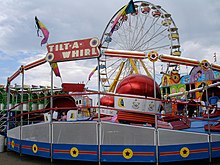Tilt-A-Whirl

Tilt-A-Whirl, also known as Waltzer in Europe, is one of the best-known flat rides, designed for commercial use at amusement parks, fairs and carnivals in which it is commonly found.[1] The rides are manufactured by Larson International of Plainview, Texas.
The Tilt-A-Whirl is a platform-type ride, consisting of seven freely-spinning cars that hold three (sometimes four) riders each, which are attached at fixed pivot points on a rotating platform. As the platform revolves, parts of the platform are raised and lowered, and the resulting centrifugal and gravitational forces on the cars cause them to spin in different directions and at variable speeds. The weight of passengers in these cars (as well as the weight distribution) may intensify or dampen the spinning motion of the cars, adding to the unpredictable nature of the motion. Mathematicians call this unpredictable nature chaotic motion.
Physicists Bret M. Huggard and Richard L. Kautz came up with a mathematical equation that approximates the motion of the Tilt-A-Whirl.[2] Although it was without knowledge of chaos theory that Herbert Sellner invented the ride, in his patent text he clearly demonstrates an appreciation of chaos – "A further object is to provide amusement apparatus wherein the riders will be moved in general through an orbit and will unexpectedly swing, snap from side to side or rotate without in any way being able to figure what movement may next take place in the car."
History
Herbert W. Sellner, a woodworker and maker of water slides, invented the Tilt-A-Whirl in 1926, at his Faribault, Minnesota, home. Over the next year, the first 14 Tilt-A-Whirls were built in Herbert's basement and yard. In 1927, Sellner Manufacturing opened its factory in Faribault, and the ride debuted that year at the Minnesota State Fair.
The earliest Tilt-A-Whirls were constructed of wood, powered by a gas motor, and featured nine cars. Today, the ride is constructed of steel, aluminum and fiberglass It is powered by seven small electric motors, and has seven cars.
In 1995, Tovah Sellner took over Sellner Manufacturing after the loss of her husband Bruce Sellner; her daughter Erin Sellner joined her in 1998 and the two of them ran the business together.
Tilt-A-Whirls today
Since 1927, Sellner has manufactured more than a thousand Tilt-A-Whirls. Some of the rides produced in the 1940s and 1950s are still in operation. The rides were originally designed and built at the factory in Faribault, Minnesota.
A new Tilt-A-Whirl costs in excess of USD $300,000 to purchase.
The oldest currently operating Tilt-A-Whirl is a 1927 model, still traveling with Tom Evans United Shows in the midwest. Between six- and seven hundred Tilt-A-Whirls are still in operation.
Conneaut Lake Park in Conneaut Lake, Pennsylvania still has its original Tilt-A-Whirl from 1949.
References
- ^ Rides for Amusement Parks, Carnivals, and Fairs – Made in the USA
- ^ Kautz, R.L., and B.M. Huggard. 1994. Chaos at the amusement park: Dynamics of the Tilt-A-Whirl. American Journal of Physics 62(January):59.
Further reading
- "It's been a tilting, whirling ride for 75 years," Minneapolis Star Tribune, 1-SEP-2001
- U.S. patent 1,745,719 The Tilt-A-Whirl patent.
- Tilt-A-Whirl Chaos (I) Ivars Peterson's MathTrek
- Tilt-A-Whirl Chaos (II) Ivars Peterson's MathTrek
- Amusement Ride Extravaganza – Tilt-A-Whirl


